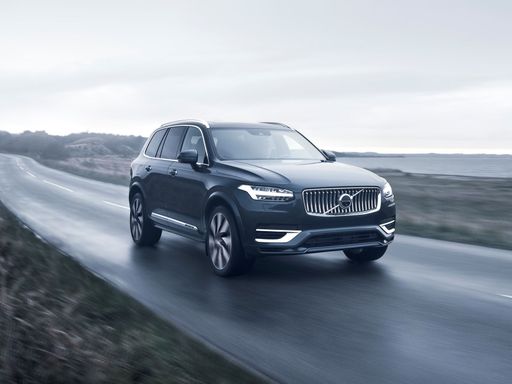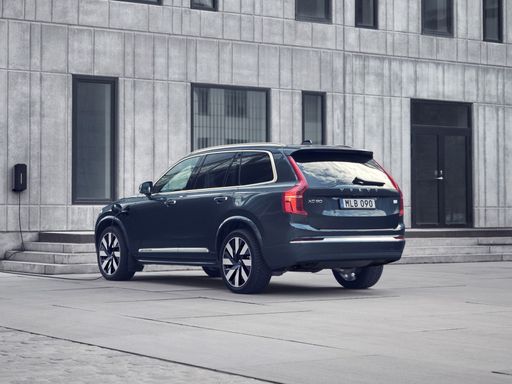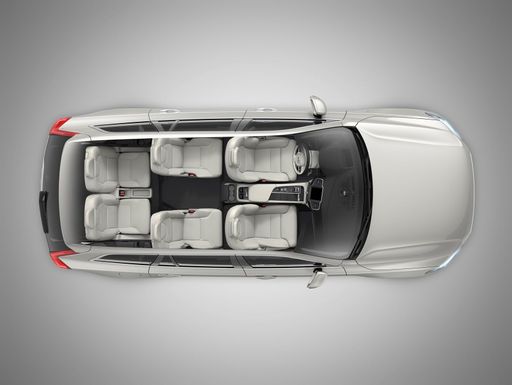Volvo XC90 vs VW Transporter Bus – Differences & prices compared
Everyday use, family trips or long-distance drives – here’s where the differences show.
Discover whether Volvo XC90 or VW Transporter Bus fits your lifestyle better.
Battle of Titans: Volvo XC90 vs. VW Transporter Bus
The automotive industry is a panorama of diversity, where variety reigns supreme and each vehicle caters to distinct niches. For individuals and families considering practicality, space, and innovation, both the Volvo XC90 and the VW Transporter Bus stand as top contenders. Let's delve into the technical allure and innovative edges these two models deliver.
Design and Dimensions
The Volvo XC90, an architectural marvel in the SUV category, boasts a sleek body with dimensions of 4953mm length, 1923mm width, and 1771mm height. Meanwhile, the VW Transporter Bus, a stalwart in the bus category, flexes a muscular presence with variants reaching up to 5450mm in length and widths skirting between 1941mm to 2032mm. The Transporter's height, peaking at 1997mm, equates command with a robust road stance, setting a precedent in spacious travel.
Powertrain and Performance
Under the hood of the Volvo XC90 lies sophistication with a choice between a petrol mild hybrid and a plug-in hybrid engine. Power outputs range from 250 to a striking 455 HP, supported by an all-wheel-drive system and an acceleration scenario from 0 to 100 km/h in 5.4 to 7.7 seconds. Every XC90 is engineered with automatic gearbox precision, achieving top speeds of 180 km/h.
The VW Transporter Bus is expansive in its engine offerings, from diesel and petrol to plug-in hybrid and electric configurations. With horsepower ranging from 110 to 286, and torque values hovering between 310 to 415 Nm, the Transporter taps into diverse power demands. Acceleration ranges from a moderate 16.9 seconds to a nimble 7.4 seconds for a sprint to 100 km/h, with a maximal speed of 200 km/h.
Innovations and Amenities
Volvo's XC90 packs a tech punch with its high-end electrified options. The plug-in hybrid version flaunts a 71 km electric range, propelled by a 14.7 kWh battery. Its emphasis on eco-efficiency is illustrated by CO2 emissions as low as 30 g/km, underscoring Volvo's commitment to sustainability without compromising luxury.
VW Transporter Bus reveals innovation in modularity and flexibility. Its wide-ranging powertrains include an electric version with a robust 324 km range on a solid 63.8 kWh capacity battery, catering especially to environmentally conscious journeys. The Transporter's payload capacitation peaking at 1143 kg further accentuates its practical appeal.
Interior and Capacity
The XC90 epitomizes plush comfort with its seven-seater capability, while the VW Transporter Bus transcends convenience with seating configurations accommodating up to eight passengers. The Transporter's additional advantage is its generous trunk capacity, which maxes out at 763 liters, reinforcing its role as the quintessential family or group travel option.
Final Verdict
When juxtaposed, the Volvo XC90 and VW Transporter Bus serve distinctly satisfying experiences, each catering to unique preferences. Volvo's prestige lies in its hybridized innovation and robust luxury, constructing an ideal oasis for the modern SUV aficionado. Contrarily, the VW Transporter Bus commands with versatility and pragmatism, making it an invaluable companion for those in need of spacious and sustainable travel options. Whether one seeks the road-aurora glamour of the XC90 or the accommodating frontier of the Transporter, both vehicles promise an exemplary ride while championing their mores.
Here’s where it gets real: The technical differences in detail
Costs and Efficiency: Looking at overall running costs, both models reveal some interesting differences in everyday economy.
VW Transporter Bus has a convincingly advantage in terms of price – it starts at 41500 £, while the Volvo XC90 costs 69800 £. That’s a price difference of around 28284 £.
Fuel consumption also shows a difference: the VW Transporter Bus manages with 0.80 L and is therefore convincingly more efficient than the Volvo XC90 with 3.50 L. The difference is about 2.70 L per 100 km.
As for range, the VW Transporter Bus performs clearly better – achieving up to 324 km, about 253 km more than the Volvo XC90.
Engine and Performance: Power, torque and acceleration are the classic benchmarks for car enthusiasts – and here, some clear differences start to show.
When it comes to engine power, the Volvo XC90 has a noticeable edge – offering 455 HP compared to 286 HP. That’s roughly 169 HP more horsepower.
In acceleration from 0 to 100 km/h, the Volvo XC90 is noticeable quicker – completing the sprint in 5.40 s, while the VW Transporter Bus takes 7.40 s. That’s about 2 s faster.
In terms of top speed, the VW Transporter Bus performs slight better – reaching 200 km/h, while the Volvo XC90 tops out at 180 km/h. The difference is around 20 km/h.
There’s also a difference in torque: the Volvo XC90 pulls decisively stronger with 709 Nm compared to 415 Nm. That’s about 294 Nm difference.
Space and Everyday Use: Whether family car or daily driver – which one offers more room, flexibility and comfort?
Seats: VW Transporter Bus offers to a small extent more seating capacity – 8 vs 7.
In curb weight, the VW Transporter Bus is hardly perceptible lighter – 1998 kg compared to 2080 kg. The difference is around 82 kg.
In terms of boot space, the VW Transporter Bus offers clearly more room – 763 L compared to 302 L. That’s a difference of about 461 L.
In maximum load capacity, the VW Transporter Bus performs significantly better – up to 4005 L, which is about 2149 L more than the Volvo XC90.
When it comes to payload, VW Transporter Bus evident takes the win – 1143 kg compared to 710 kg. That’s a difference of about 433 kg.
Our conclusion: The VW Transporter Bus proves to be wins the duel decisively and thus becomes our DriveDuel Champion!
Overall, VW Transporter Bus is the better all-rounder in this comparison.
Volvo XC90
The Volvo XC90 stands out with its elegant Scandinavian design, seamlessly blending luxury with versatility. Inside, it offers a spacious and meticulously crafted interior, showcasing high-quality materials and advanced technology. The vehicle provides a comfortable and smooth driving experience, making it a popular choice for families and long journeys.
details @ media.volvocars.com
@ media.volvocars.com
 @ media.volvocars.com
@ media.volvocars.com
 @ media.volvocars.com
@ media.volvocars.com
 @ media.volvocars.com
@ media.volvocars.com
 @ media.volvocars.com
@ media.volvocars.com
VW Transporter Bus
The VW Transporter Bus from Volkswagen Commercial Vehicles is a versatile and reliable choice for both business and leisure purposes. It offers ample space and a flexible interior, making it ideal for transporting passengers or goods comfortably. The vehicle combines practicality with modern styling, ensuring it meets the demands of everyday use while maintaining an eye-catching appearance.
details

|
|
|
|
|
Costs and Consumption |
|
|---|---|
|
Price
69800 - 84600 £
|
Price
41500 - 85100 £
|
|
Consumption L/100km
3.5 - 8.5 L
|
Consumption L/100km
0.8 - 9.2 L
|
|
Consumption kWh/100km
-
|
Consumption kWh/100km
22.4 - 24.9 kWh
|
|
Electric Range
71 km
|
Electric Range
87 - 324 km
|
|
Battery Capacity
14.70 kWh
|
Battery Capacity
11.8 - 63.8 kWh
|
|
co2
79 - 191 g/km
|
co2
0 - 229 g/km
|
|
Fuel tank capacity
71 L
|
Fuel tank capacity
45 - 60 L
|
Dimensions and Body |
|
|---|---|
|
Body Type
SUV
|
Body Type
Bus
|
|
Seats
7
|
Seats
4 - 8
|
|
Doors
5
|
Doors
4 - 5
|
|
Curb weight
2080 - 2297 kg
|
Curb weight
1998 - 2620 kg
|
|
Trunk capacity
262 - 302 L
|
Trunk capacity
0 - 763 L
|
|
Length
4953 mm
|
Length
4973 - 5450 mm
|
|
Width
1923 mm
|
Width
1941 - 2032 mm
|
|
Height
1771 mm
|
Height
1907 - 1997 mm
|
|
Max trunk capacity
1816 - 1856 L
|
Max trunk capacity
3672 - 4005 L
|
|
Payload
653 - 710 kg
|
Payload
330 - 1143 kg
|
Engine and Performance |
|
|---|---|
|
Engine Type
Petrol MHEV, Plugin Hybrid
|
Engine Type
Diesel, Petrol, Plugin Hybrid, Electric
|
|
Transmission
Automatic
|
Transmission
Manuel, Automatic
|
|
Transmission Detail
Automatic Gearbox
|
Transmission Detail
Manual Gearbox, Automatic Gearbox, Dual-Clutch Automatic
|
|
Drive Type
All-Wheel Drive
|
Drive Type
Front-Wheel Drive, All-Wheel Drive, Rear-Wheel Drive
|
|
Power HP
250 - 455 HP
|
Power HP
110 - 286 HP
|
|
Acceleration 0-100km/h
5.4 - 7.7 s
|
Acceleration 0-100km/h
7.4 - 16.9 s
|
|
Max Speed
180 km/h
|
Max Speed
112 - 200 km/h
|
|
Torque
360 - 709 Nm
|
Torque
310 - 415 Nm
|
|
Number of Cylinders
4
|
Number of Cylinders
4
|
|
Power kW
184 - 335 kW
|
Power kW
81 - 210 kW
|
|
Engine capacity
1969 cm3
|
Engine capacity
1498 - 2488 cm3
|
General |
|
|---|---|
|
Model Year
2024 - 2025
|
Model Year
2024 - 2025
|
|
CO2 Efficiency Class
G, B
|
CO2 Efficiency Class
G, F, B, A
|
|
Brand
Volvo
|
Brand
VW
|
What drivetrain options does the Volvo XC90 have?
Available configurations include All-Wheel Drive.
The prices and data displayed are estimates based on German list prices and may vary by country. This information is not legally binding.
